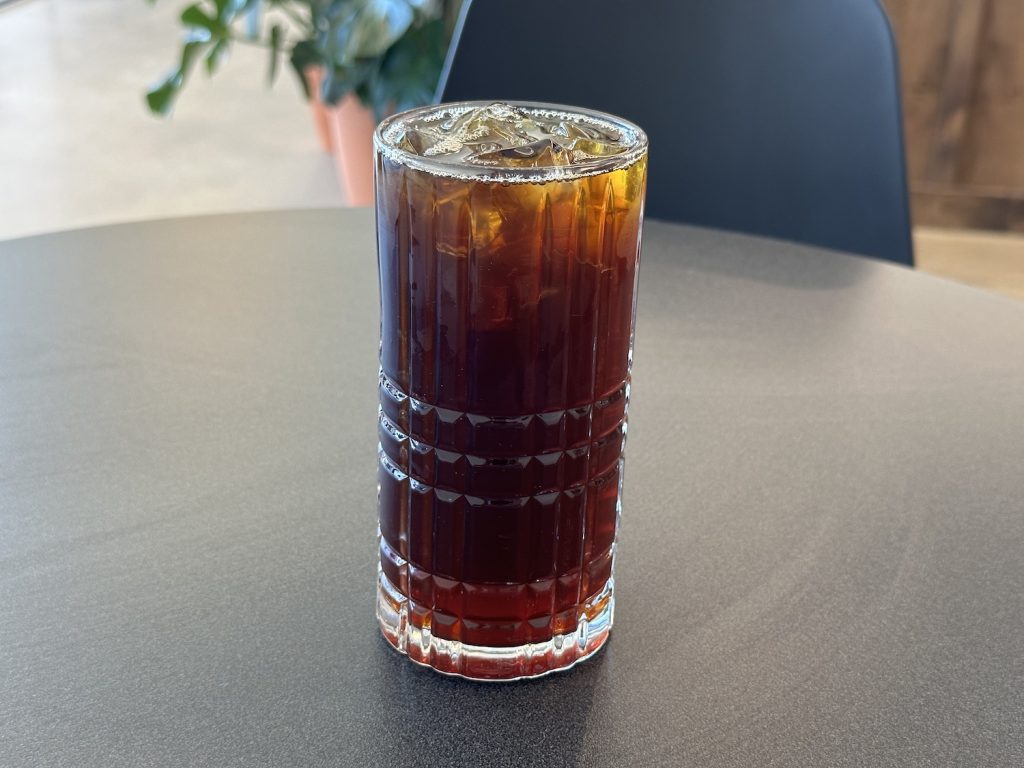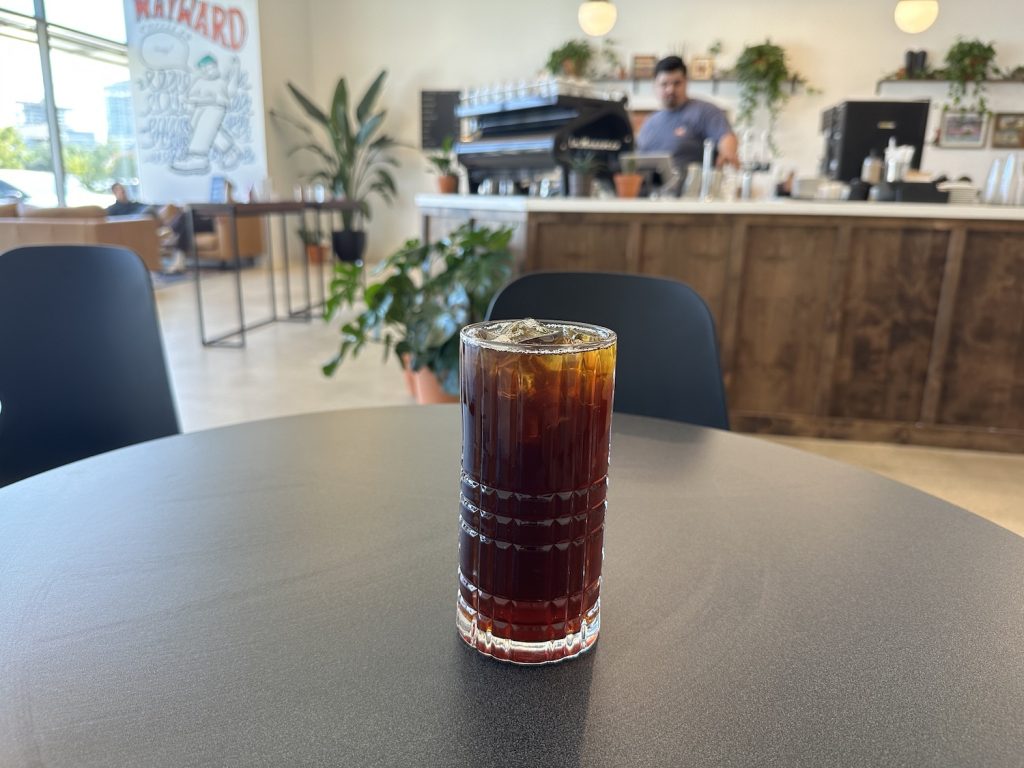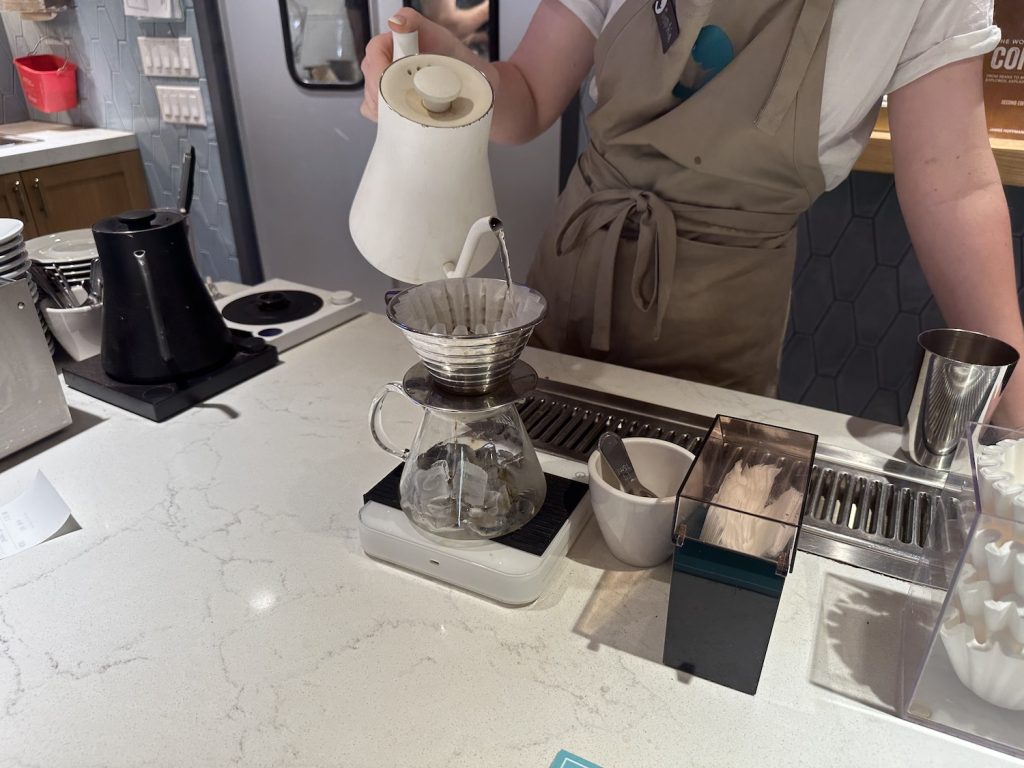
by Lars H
I thought I had heard of most kinds of coffee. But strangely, I had never heard of flash coffee before, also known as flash brewed coffee. Flash coffee is a Japanese pour over coffee method that makes a cold, iced coffee.
It seemed interesting, but also confusing as to how it was different than regular pour over ice coffee. So I did some searching and found a coffee shop in Dallas that makes flash brew pour over coffee and drove their to check it out for myself. I asked the barista some questions about it and even took some photos so you can see for yourself how it works.
The barista at Wayward coffee on Irving Blvd in Dallas was very patient and helpful in explaining how flash coffee works. I didn’t get it at first and I had to keep asking questions again and again, stated differently. And then it finally started to make sense to me.
Here is my explanation based on the barista’s patient explanation to me.

What is flash brew coffee, exactly?
Flash brew coffee, also known as Japanese iced coffee, is a method of brewing coffee that involves brewing hot coffee directly onto ice. The process is designed to lock in the flavors and aromatics of the coffee that can be lost when coffee is brewed hot and then cooled down over time.
Here’s a basic process for making flash brew coffee:
- Grind your coffee beans: The grind size should be similar to what you would use for a pour-over or drip coffee.
- Prepare your ice: Fill your carafe or coffee pot with ice. The amount of ice should be about half of the total water volume you’re using to brew.
- Brew your coffee: Using a pour-over cone or automatic drip machine, brew your coffee directly onto the ice. The water you’re using to brew should be the other half of the total water volume.
- Stir and serve: Once the brewing process is complete, give your coffee a good stir to make sure all the ice has melted and the coffee is cooled. Then, serve it with additional ice if desired.
The result is a crisp, refreshing iced coffee with a clear flavor profile. It’s a great method to use with single-origin coffees where you really want the unique flavors to shine.
How much water do you put through the pour over device to make flash coffee?
The amount of water you pour through the pour-over depends on the coffee-to-water ratio you’re using. A common ratio for coffee brewing is the golden ratio of 1:16, meaning 1 part coffee to 16 parts water.
Let’s say you’re making a 16-ounce serving of flash brew coffee. Here’s how you would calculate the amount of water to pour:
- Determine the amount of coffee: Using the 1:16 ratio, if you’re making 16 ounces of coffee, you would use 1 ounce (28 grams) of coffee, which you typically weigh out with a coffee scale.
- Split the water into two parts: Since you’re making flash brew, you would split the 16 ounces of water into two 8-ounce parts. One part is ice, and the other part is the hot water you’ll use for brewing.
So, in this case, you would put 8 ounces of ice into your carafe, and then you would pour 8 ounces of hot water over the 1 ounce of coffee in your pour-over. The hot coffee would then drip onto the ice, cooling it rapidly and creating a 16-ounce serving of flash brew coffee.
But do you weigh 8 ounces of ice? How do you know if it is 8 ounces?
The key to understanding this lies in the brewing ratio, which is the ratio of coffee to water used in the brewing process.
When making flash brew coffee, you’re still using the same amount of coffee grounds as you would for a regular hot brew. However, you’re splitting the water into two parts: half is hot water used to brew the coffee, and the other half is ice that the coffee is brewed onto.
When you brew the coffee with the hot water, you’re essentially making a coffee concentrate because you’re using less water to extract the coffee flavors. This concentrate is strong and flavorful. When this hot coffee concentrate hits the ice, it cools down rapidly, and the ice melts, diluting the concentrate back to the strength of a regular brew.
So, even though you’re using less water to brew, the ice compensates for the rest of the water, ensuring that the coffee isn’t weak. The rapid cooling also helps to lock in the flavors and aromatics of the coffee, resulting in a bright and flavorful iced coffee.

How does flash coffee taste?
I would describe flash brew coffee to have a similar taste profile to cold brew. I think dripping the pour over onto ice and immediately cooling it takes away the bitterness a lot like the cold brewing process does, only you can make it whenever you want!
There were many different beans to choose from at Wayward that day, so I asked the barista to help me pick out beans that weren’t too fruity and had more traditional coffee notes. He recommended an Ethiopian coffee (the birthplace of coffee!), so I went with his suggestion.
The barista did a great job picking out beans that I did enjoy. I got a lot of traditional coffee notes without the sour or fruity tastes that aren’t really my favorite. Those notes, and the smooth, non-bitterness of the flash coffee method made for a very enjoyable iced coffee. I drank it black just like it was pictured, with no sweetener of any kind.
The only downside to flash coffee was the cost and the extra wait time for them to make it. My coffee was $6.50 before the option of leaving a tip, which I obviously did because the barista took a lot of time explaining flash coffee to me.
I would consider an almost $7 coffee to be a special occasion coffee, because it’s out of my budget to drink something like that every day. But I’d definitely order it again if I were at a high end shop like Wayward and they had some interesting beans to try out. Because flash coffee is good!

Flash Coffee at White Rhino Coffee
Turns out that a few days later I was over at White Rhino Coffee in Uptown, Dallas, and they also served flash brew coffee, and at a lower price of just $4.50. They had a couple of different single origin choices, and I went with the Costa Rican coffee, which turned out to be very good.
I asked more questions about flash coffee as the barista was making it, and she gave me some new details that I didn’t know yet.
When they make a flash brew there, they use 21 grams of ground coffee, 100 grams of ice (they weigh it on the scale), and then pour 250 grams of hot water over the pour over device to make the coffee. Since you pour less water through the coffee, what they do at White Rhino is use a finer grind, so you get more immersion and the coffee is nice and strong as it melts the ice. So that’s another reason why flash coffee doesn’t taste weak, even though you’re only pouring half as much water through the grounds and filter.
As at Wayward, the resulting flash brew iced coffee was nice and smooth, with no bitterness. I would describe their flash brew as bolder than the flash coffee I got at Wayward, but similarly smooth in a way that reminded me of how a cold brew tastes.
